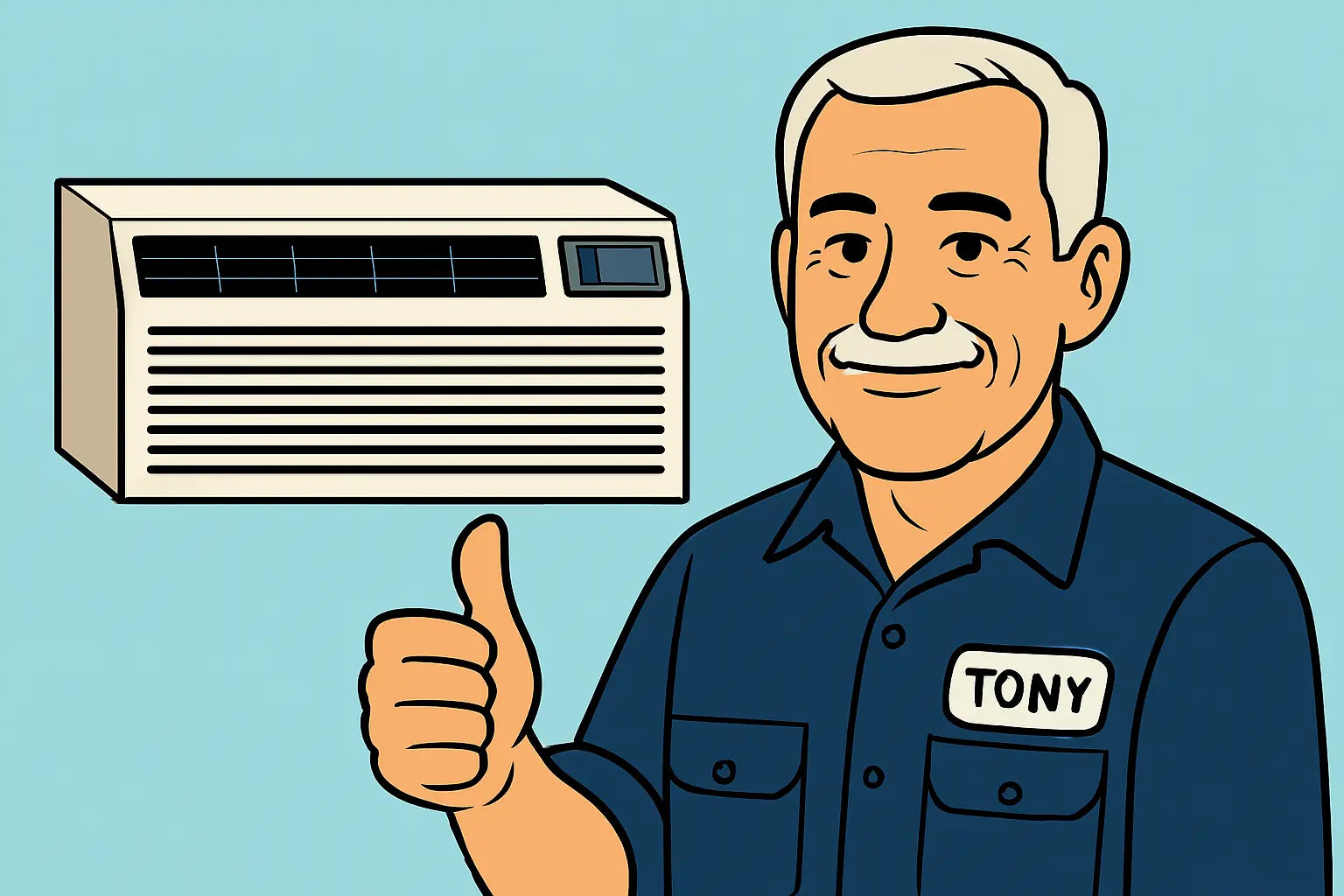Intro from Tony
Hey friends, Tony checking in. You’ve installed your Amana Distinctions 12,000 BTU PTAC with 3.5 kW electric heat, and it’s humming along. But here’s the thing: even the best PTAC won’t stay efficient without regular maintenance. Dust, dirt, and electrical wear sneak in quietly, and before you know it, cooling slows, heating struggles, or water starts pooling.
I’m going to break down filter maintenance, coil cleaning, and electrical checkups so you can keep your unit running efficiently for years. Plus, I’ll sprinkle in some pro tips that save you time and money. 🛠️💨
1. Why Maintenance Matters
Regular PTAC upkeep:
-
Ensures efficient cooling and heating
-
Prevents water leaks and mold growth
-
Reduces energy bills
-
Extends unit lifespan
Think of your PTAC like a car—skip oil changes and eventually you’re stuck on the side of the road. Skip maintenance here, and your comfort and wallet take a hit.
For an overview of PTAC efficiency and maintenance, check Energy Star’s PTAC guide.
2. Filter Checkups
2.1 Why Filters Matter
Filters trap dust, hair, and other debris before it reaches coils or fan blades. A clogged filter:
-
Reduces airflow
-
Forces the unit to work harder
-
Lowers cooling and heating efficiency
2.2 How to Inspect and Replace Filters
-
Turn off and unplug the PTAC.
-
Remove the front grille.
-
Inspect the filter—replace if dirty, or wash if reusable.
-
Slide the clean filter back in and reinstall the grille.
2.3 Maintenance Frequency
-
Monthly in dusty environments
-
Every 2–3 months for average conditions
For a visual step-by-step, see Bob Vila’s filter cleaning guide.
3. Coil Cleaning
3.1 Evaporator and Condenser Coils
Coils transfer heat—dirty coils reduce efficiency and can lead to water buildup or freezing.
3.2 DIY Coil Cleaning Steps
-
Power off and unplug the PTAC.
-
Remove the front panel and inspect coils.
-
Gently vacuum or use a soft brush to remove dust.
-
If heavily soiled, use a coil cleaner recommended for PTAC units.
-
Reassemble the panel and test the unit.
3.3 Signs Coils Need Attention
-
Weak cooling or heating
-
Frost or ice formation on coils
-
Musty smell from the unit
For more on coil care, check HD Supply’s AC maintenance tips.
4. Electrical Checkups
4.1 Why Electrical Maintenance Matters
Loose or corroded connections can lead to:
-
Intermittent operation
-
Tripped breakers
-
Component damage
4.2 DIY Electrical Checks
-
Turn off the breaker before touching anything.
-
Inspect wiring for wear, corrosion, or loose connections.
-
Check that the LCDI cord (if applicable) is reset.
-
Test the unit using a multimeter for proper voltage.
4.3 When to Call a Pro
-
Persistent tripping of breakers
-
Burnt smells or visible damage
-
Unfamiliar wiring issues
For a full guide to PTAC electrical safety, see HVAC School’s tips.
5. Additional Maintenance Tips
-
Condensate pan: Check and clear every 3–6 months
-
Fan blades: Inspect and clean debris every 6 months
-
Sleeve tilt: Check annually to avoid leaks (covered in our previous blog)
For deeper insight into PTAC preventive care, see HVAC Senior PTAC guide.
6. Seasonal Maintenance Checklist
| Task | Frequency | Tips |
|---|---|---|
| Filter inspection | Monthly | Wash or replace |
| Coil cleaning | Every 6 months | Avoid bending fins |
| Electrical inspection | Annually | Turn off breaker first |
| Condensate drain | 3–6 months | Flush with mild solution |
| Sleeve tilt | Annually | Check slope toward outside |
7. Troubleshooting Common Maintenance Issues
| Symptom | Possible Cause | DIY Fix | Call Pro If… |
|---|---|---|---|
| Weak airflow | Clogged filter | Clean/replace | No improvement |
| Water pooling | Clogged pan | Clear drain, check tilt | Persistent leaks |
| Poor heating | Dirty coils or electrical issue | Clean coils, check power | Strip heat fails |
| No cooling | Frozen coil | Defrost, check filter | Refrigerant suspected low |
| Unusual noise | Loose parts or fan | Tighten/clean | Motor or compressor issues |
Wrap Up from Tony
And that’s your Tony-approved maintenance guide for the Amana Distinctions 12,000 BTU PTAC with 3.5 kW electric heat. Keep your filters clean, your coils sparkling, and your wiring tight, and your unit will hum along efficiently for years.
If you’re ready to grab the exact model or need reference specs, check out The Furnace Outlet’s Amana Distinctions PTAC. Maintain it right, and enjoy worry-free comfort all year round. 🍻
Curious about DIY or professional repair? Visit my guide: The Guide to Repairing Your Amana Distinctions PTAC.
Until next time,
- Tony the Trusted Tech







